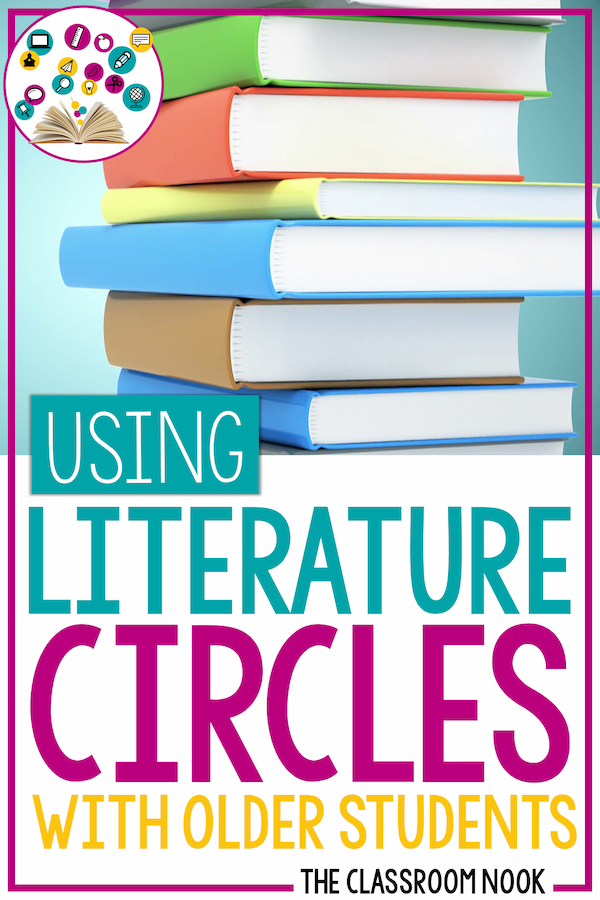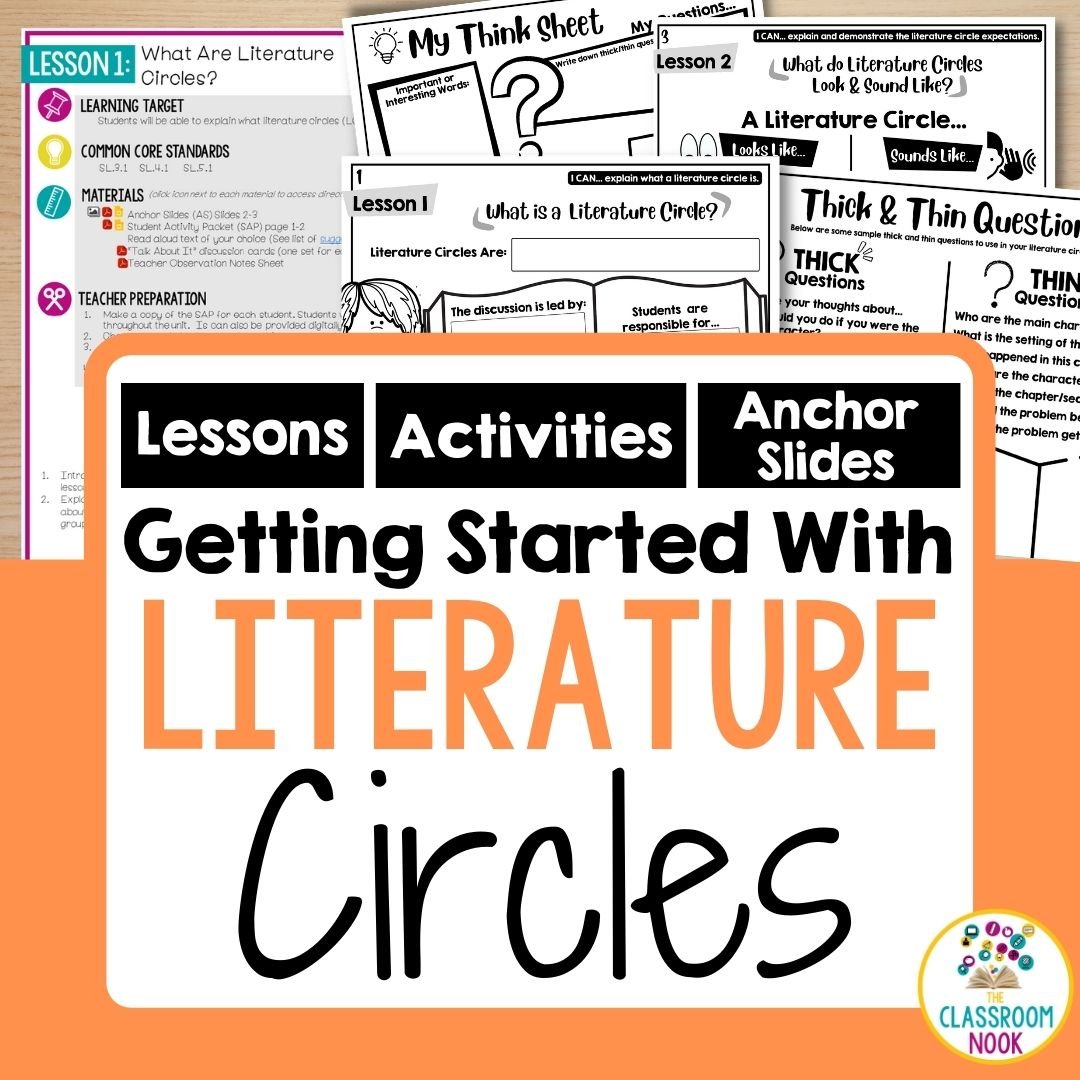Using Literature Circles and Book Clubs in the Upper Elementary Classroom
Love podcasts? Listen to this post in the form of a podcast episode on The Classroom Commute Podcast!

Veteran teachers would agree that a major component to successful reading instruction is variety. Variety in the types of books your students read, variety in how you present new skills and strategies, and variety in the ways that students interact with books and each other.
If your reading instruction is looking for a bit of a shake up, then literature circles might be just the variety that you and your students need to breathe new life into your reading block together!
First implemented in the 1980’s, literature circles are meant to encourage student-centered discussions. They also provide a more flexible atmosphere. In literature circles, students are allowed greater choice of what they study, and greater independence to collaborate as a group.
You May Also Like to Read: GIVING STUDENTS MORE CHOICE IN THE CLASSROOM
WHAT ARE LITERATURE CIRCLES:
At its most basic, a literature circle is a group of students who gather to read, study and discuss books that they have chosen. The discussion is led by the students, and each member of the circle is expected to participate. Members of the literature circle work together to deepen their understanding of the text through verbal, written, and artistic responses. Individuals in a literature circle are assigned roles that allow them to guide the discussion of various aspects of the text. Roles assigned might include:
Word Collector - Makes a list of interesting words found in the text
Questioner - Creates a list of questions to be used to spur discussion
Illustrator - Draws important characters, events or settings from the reading
Connector - Makes Text-to-Text, Text-to-Self, and Text-to-World connections from the reading
Summarizer - Writes a brief summary of what the group read prior to meeting
Students come prepared with what I call a "Think Sheet," specific to their role. When groups meet with their literature circles, they will share their "Think Sheet" with their group. This is a guide to support students who are just getting started with using literature circles. These sheets help guide conversations and keep everyone accountable for their reading.
As students become fluent in each role, you may decide to have students transition into performing all roles, each time they read. They can complete a sheet that looks like the one on the left that has them complete activities for each role.
Literature circles are meant to be one part of a balanced literacy curriculum, as opposed to a replacement. They are meant to be an aid in development of critical thinking and reflection skills. They’re not an entire program, but another tool that teachers can use to help foster a true love of reading.
Literature circles allow students independence, but they aren’t a free-for-all. They’re structured by the teacher in such a way that students can take responsible, accountable ownership of their learning experience. I think you’ll find that being granted this ownership is a really great motivator for your students!
WHY USE LITERATURE CIRCLES?
Collaboration: Literature circles encourage cooperative learning. Students in a circle use each other as resources, and help one another understand what they are reading. This happens by design, of course. In order for a literature circle to be effective, the teacher must provide guidance and support.
Choice: In Literature circles, students are usually allowed to select one of several books to study. The opportunity to make their own (guided) choice leads students to feel more engaged and motivated. They will be more likely to really want to read the book.
Voice: Strangely enough, students sometimes tire of listening to the teacher talk (Ha!)! Literature circles give students the opportunity to do the talking. They can voice their opinion, offer their own analysis, and engage in productive discussion with friends, as well as with other students that they might otherwise not talk to.
Fun: In a literature circle, students are encouraged to talk. A lot. For most kids, that’s fun. There aren’t many opportunities during class time for social experiences of this sort. Making reading fun is crucial for encouraging reluctant or struggling readers.
You May Also Like to Read: HOW TO: GET STARTED WITH READING PARTNERSHIPS IN THE CLASSROOM
SETTING BEHAVIORAL EXPECTATIONS FOR LITERATURE CIRCLES:
Make no mistake, monitoring multiple literary circles can be challenging. Not all students have learned the necessary skills to cooperate in small groups. The teacher has to invest significant time beforehand showing students how to work collectively.
There are any number of potential distractions that can knock a group(s) off task. For example, the noise level from one group might prevent other groups from concentrating. Literature circles can also be overwhelming for the teacher, because so many things are going on at once. For literature circles to function properly, students have to be firmly guided, and trained to take on the necessary responsibility.
I love using a simple "Looks Like/Sounds Like" T-chart where I teach students what their literature circle should look like (ex. all students looking at the speaker, everyone on task, all materials out...etc) and what it should sound like (ex. low voices, one person talking at a time, on-task conversations...etc)
You’ll want to remind all students of your expectations as you begin literature circles each time, especially when first starting them. Most students enjoy group work enough that behavior issues can be dealt with by simple reminders.
Another thing to keep in mind is that all students should be participating fully during literature circles. If you notice a student shying away from the conversation, discuss it with that student, or join the group for a moment and draw that student into the discussion with a direct question.
ENCOURAGING MEANINGFUL DISCUSSION & ACCOUNTABILITY IN LITERATURE CIRCLES:
Learning to participate (both by listening and by contributing) in a meaningful discussion can be difficult for students, especially when first starting out with literature circles. Simply finding something to say about what has been read may requires skills that many students have not yet developed. Kids have to be taught, and given plenty of examples of, how to discuss a topic in depth.
First, it’s necessary to define exactly what makes for a good discussion. In a good, meaningful discussion, all participants are accountable. In other words, they do things like:
Listen closely and carefully
Add on to each other's comments
Use clarifying questions to make sure they fully understand what others have said
Participate in respectful debate
A good way to teach students the skill of meaningful conversation is by providing them with examples of “Accountable Talk”. The overall concept of Accountable Talk can be broken down into three simple groups of ideas or phrases that students can practice using:
Phrases to add on – Used when a student has something to add to what is being said (Also, I think…Have you thought about…I agree/disagree because…)
Phrases to clarify – Used when a student doesn’t understand something another has said (I was wondering…Could you explain…When you said ____, I didn’t understand…)
Question phrases – Used to keep conversation flowing/give the group something to think about (Does anyone think…How would YOU feel if…I was wondering…)
FREE Set of Posters
Help encourage accountable talk with your students by introducing and displaying these 3 Accountable Talk Posters!
PLUS: Provide students with the printable reference sheet to keep on hand during small group discussion!
Next, you’ll need to develop some discussion guidelines. It’s best to keep the list of discussion guidelines short. Just include those points that are most important to your class. Some examples of discussion guidelines are:
Be prepared
Listen carefully
Everyone participates in discussion
No interruptions
Be open to others’ ideas
No put-downs
Help others to understand
Finally, it’s important to remember what students learning to participate in meaningful discussions need most - practice, practice, practice! This is a skill that will only develop gradually, over an extended period of time. Patience with the students, and with yourself, is a must!
Literature circles are a powerful tool to use in your classroom. Done correctly, they will get your students truly excited about reading! Literature circles will also teach them how to:
Work collaboratively
Responsibly exercise choice in selecting subject matter
Use their voices confidently, productively, and respectfully
Have fun while learning!
When students learn to work together, be accountable, and take responsibility for their own learning, the results are positive and rewarding. Literature Circles are the perfect way to create a positive community of readers.
You May Also Like to Read: CREATING A COMMUNITY OF READERS (Part 1) and (Part 2)
Ready to hit the ground running with literature circles, but need a little guidance?
Check out this resource that will have literature circles up and running with success:




